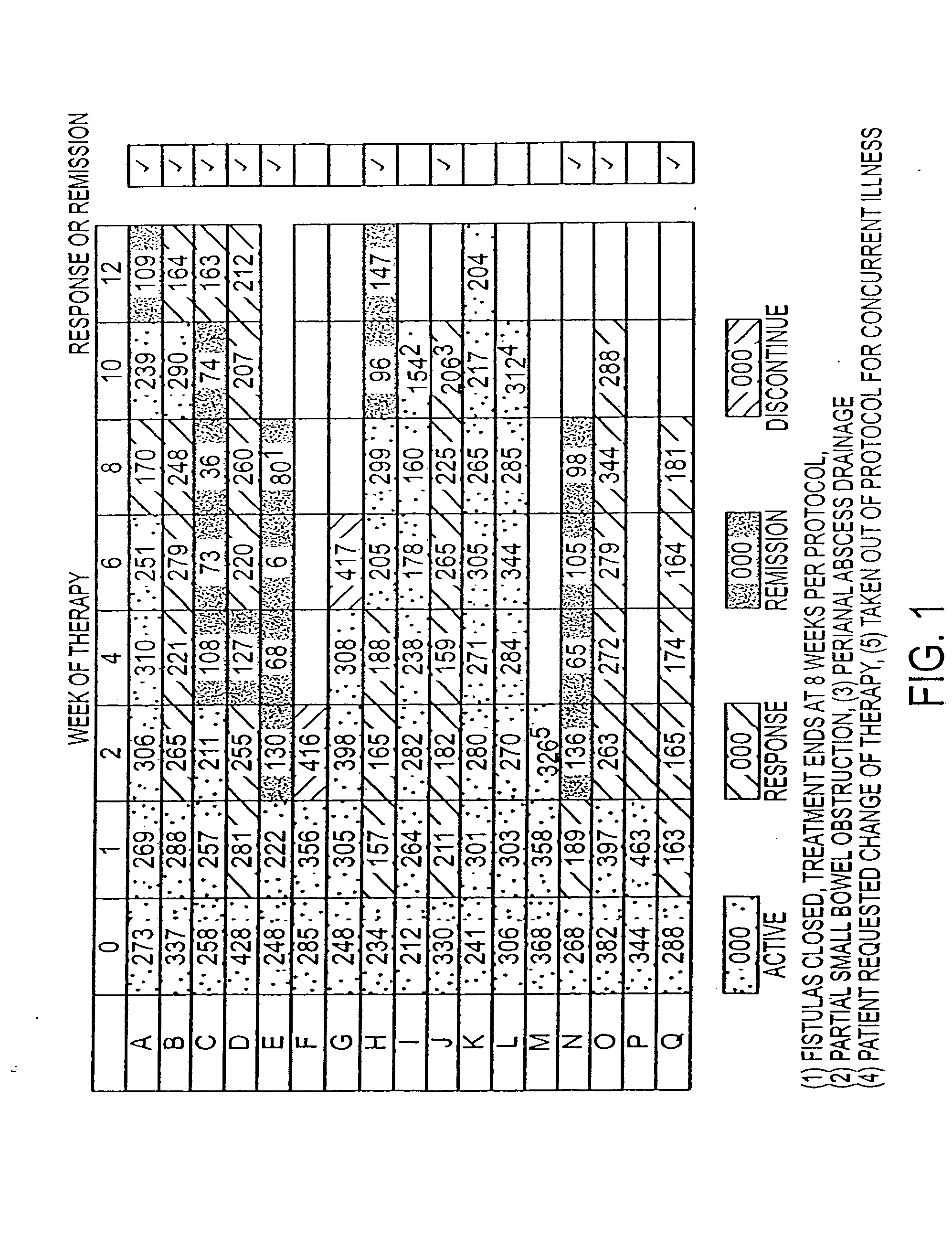Stimulating neutrophil function to treat inflammatory bowel disease
- Summary
- Abstract
- Description
- Claims
- Application Information
AI Technical Summary
Benefits of technology
Problems solved by technology
Method used
Image
Examples
example 1
[0052] This example shows the treatment of 3 Crohn's disease patients with GM-CSF. All three meet the definition of treatment response (CDAI decrease of greater than 70). Patients 2 and 3 are very early in their treatments and it appears likely that they will go into remission. The protocol employed is described below.
Patient 1PretreatmentCDAI340.4Week 1CDAI344.4Week 2CDAI285.6Week 3CDAI286.6Week 5CDAI276.4Week 6CDAI299.4Week 8CDAI209.2Patient 2PretreatmentCDAI349.6Week 1CDAI274.0Week 2CDAI227.0Week 3CDAI216.6Patient 3PretreatmentCDAI410.8Week 1CDAI299.0Week 2CDAI231.4
example 2
[0053] This example demonstrates the treatment of 17 Crohn's disease patients with G-CSF.
[0054] Subjects were enrolled with active disease (CDAI>200) or with active fistulous disease. Patients were not included if other immunosuppressants had been used for standard periods of time (4 weeks for steroids, azathioprine / 6-MP; 3 months for infliximab) and were allowed to be on 5-ASA products (if on for at least 8 weeks and same dose for at least 4 weeks). Subjects had a complete blood count (CBC) test weekly and were examined at least every other week for Crohn's Disease activity index (CDAI) determination and / or evaluation of fistulae. FIG. 2 shows the Crohn's Disease Activity Index (CDAI) at the onset (week 0) and followed over a 12-week course of treatment. Clinical “response” in Crohn's disease protocols is typically defined as a decrease in CDAI greater than 70. Ten of the 17 patients were responders, with a mean decrease in disease activity of 140 points. Seven of the ten achieved...
example 3
[0055] This example shows the protocol for a further study of the method of the present invention using G-CSF
[0056] An open-labeled trial of G-CSF for 12 weeks for patients with active CD and / or active fistulae secondary to Crohn's disease is initiated. The trial involves two separate, interrelated protocols. In conjunction with this treatment protocol, functional neutrophil studies are performed.
[0057] Treatment of active mucosal inflammation in Crohn's disease is the primary focus of Part A. Disease activity is defined by a standard Crohn's disease activity index. Patients are enrolled if they have moderate to severe disease activity using entry criteria outlined below. The study is an open-labeled study of fifteen patients with a dose titration protocol designed to provide neutrophil functional stimulation and achieve a moderate leukocytosis. Each subject is studied for twelve weeks of every day subcutaneous administration of G-CSF. Disease activity is followed by standard CDAI...
PUM
| Property | Measurement | Unit |
|---|---|---|
| Disorder | aaaaa | aaaaa |
Abstract
Description
Claims
Application Information
 Login to View More
Login to View More - R&D
- Intellectual Property
- Life Sciences
- Materials
- Tech Scout
- Unparalleled Data Quality
- Higher Quality Content
- 60% Fewer Hallucinations
Browse by: Latest US Patents, China's latest patents, Technical Efficacy Thesaurus, Application Domain, Technology Topic, Popular Technical Reports.
© 2025 PatSnap. All rights reserved.Legal|Privacy policy|Modern Slavery Act Transparency Statement|Sitemap|About US| Contact US: help@patsnap.com


